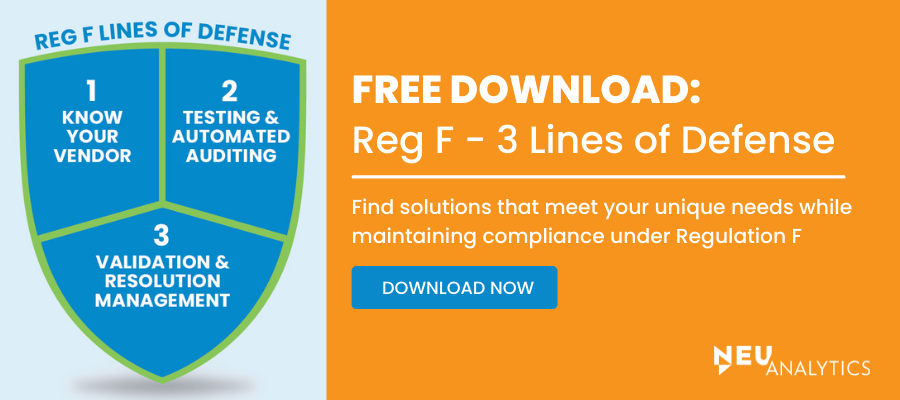It’s important for creditors to have a thorough understanding of the dispute process, and how best to manage and respond to collection disputes.
Consumer disputes happen for many reasons.
- Consumers may not understand who the creditor is
- Consumers may dispute the amount owed, payments made, or charges showing
- Consumers may question whether the debt actually belongs to them
There are many reasons an account may end up in collections: the account was forgotten, the consumer experienced financial hardship, fraudulent transactions were made without the consumer’s knowledge, and occasionally, even technical and human mistakes. Most disputes are legitimate, and all should be taken seriously.
No matter what the cause or who may be at fault, creditors need to respond in a timely and efficient manner. They must also abide by all applicable federal and state level regulations, work with their third-party agencies, and keep consumers informed, even if the process gets contentious.
This is no small task. Many disputes start out as a complaint, either directly to the collection agency or through the CFPB’s Complaint Portal. In 2021, the Consumer Financial Protection Bureau (CFPB) sent more than 750,000 complaints to approximately 3,400 companies for review and response. Complaints about credit or consumer reporting accounted for more than 70% of all consumer complaints, while debt collection accounted for more than 10% of all consumer complaints. That amounts to the CFPB getting about 121,700 debt collection complaints in 2021. Around 60% were passed on to companies for review and response, 24% were referred to other regulatory agencies, and 15% were not actionable.
Who Has to Comply?
What about financial institutions with assets less than $10 billion, or companies that are not typical financial institutions? Are they still required to comply with the dispute rules the CFPB has put forth?
In short, yes.
The CFPB’s 2021 Consumer Response Annual Report states:
“Consumers can submit complaints about creditors collecting their own debts (i.e., first-party collectors) or companies collecting debt on behalf of others, such as creditors or businesses (i.e., third-party collectors). When the CFPB received debt collection complaints about companies where it was not the primary federal regulator (e.g., a mobile phone or Internet service provider) or about depository institutions with less than $10 billion in assets, for example, it referred the complaints to other regulatory agencies (e.g., FTC) or a prudential regulator.”
Additionally, in June 2022, the CFPB’s director Rohit Chopra published a blog titled "Rethinking the approach to regulations." In that blog post, Director Chopra discussed the CFPB’s authority to register certain non-banks. The idea here is that once registered, these entities would fall under the regulatory authority of the CFPB.
So long story short, any company having business with consumers relating to financial services could fall under the CFPB’s rules.
Collection Agencies – Dispute Process
Once a consumer files a dispute, the agency is required to provide a verification of debt (VOD) to the consumer with proof of the debt, ownership, and balance.
Collection agencies usually need to reach out to their creditor clients to obtain the proof of the debt, and proof of the current balance. Once the creditor provides that information to the agency, they will pass it along to the consumer. All collection activity must stop until this proof is provided to the consumer. During the open dispute, the debt cannot be reported to the credit bureaus. If the debt has already been reported, it must be updated to notate that it is in dispute.
Credit Bureaus – Dispute Process
Consumers can also file a dispute directly with the credit bureaus, which are regulated by the Fair Credit Reporting Act (FCRA).
A credit bureau will send the dispute to either the creditor or the agency, whichever one reported the debt in the first place. After notification of the dispute, the agency or creditor has 30 days to validate the debt and respond to the credit bureau. If the debt is not validated, and the credit bureau is not notified in that 30 day period, the debt must be removed from the credit bureau.
Some consumers and credit repair businesses will routinely dispute every item on the credit report. For collection items, this is often done to slow down the process of collecting the debt to allow for the 30 days to pass in the hopes that during that time there will be a slow response from the collections agency or the debt will be non-verifiable. If the consumer has a lot of trade-lines and collection items on their credit report – this is also a way to try to eliminate some of the negative items in order to increase their credit score.
There’s no risk and no reason for a consumer or a credit repair business not to use this approach; and there’s no concern from these companies about the extra work this creates for the credit bureaus, collection agencies and creditors.
e-OSCAR
Another useful tool for creditors and collection agencies is e-OSCAR (The Online Solution for Complete and Accurate Reporting). This web-based, Metro2-compliant, automated system was developed through a collaboration among Equifax, Experian, Innovis, and TransUnion to provide an online solution to consumer credit data organizations and credit reporting agencies (CRAs) to create and respond to Automated Credit Dispute Verifications (ACDVs), and Automated Universal Data forms (AUDs). In addition to CRAs, e-Oscar is available for their affiliates and independent credit bureaus and mortgage reporting companies.
Model Validation Notice
The Fair Debt Collection Practices Act (FDCPA) used to be the only regulation on the minimum content that was required to be in the initial demand letter, but this act didn’t limit additional content to be added. With the introduction of the CFPB's Regulation F, a standard template has been instituted which provides a template for the content for the initial notice to the consumer that needs to be present. This template is named the Model Validation Notice (MVN), and requires agencies to show an itemized breakdown of the debt, provide certain disclosures, and include a tear-off at the bottom of the notice to give the consumer the option to request more information, submit a payment, or begin the dispute process more easily.
Some agencies are finding that new MVN requirements are impacting them significantly, while others report they haven’t been affected at all. The challenge in this case is that the specifics of a dispute can’t be communicated through the MVN. That means the agency is burdened with tracking down all existing records for a contested debt, and the creditor has to expend the extra effort to find and share those records.
Regulations
Regulation F and the FDCPA are under the jurisdiction of the CFPB. The FCRA is under the jurisdiction of the Federal Trade Commission (FTC), which governs how credit bureaus are required to respond to disputes. If there is a disagreement about whether the dispute falls under a federal or state/local regulation, the stricter regulation takes effect.
The CFPB also has jurisdiction over UDAAP (Unfair, Deceptive, Abusive Acts and Practices). Many scenarios relating to disputes that don’t specifically fall under Reg F, the FDCPA or the FCRA, could be determined to be unfair, deceptive, or abusive to consumers, and companies could still be fined under UDAAP even if they aren’t.
How NeuAnalytics helps
NeuAnalytics fills the gap between helping you transfer information back and forth between creditors and agencies and facilitating all the required communication while maintaining regulatory compliance. When it comes to documentation, your best option is to keep all bad debt records within a single system, even as they’re placed with multiple agencies, and keep data off the cloud, due to the sensitive nature of the information you hold with each account.
Our integrated platform tracks and stores historical collection information as records move from agency to agency. That includes disputes regarding the total balance of unpaid, overdue debt, after it goes to collections, and does not include disputes of individual charges with the original creditors. Our product suite gives you tools to respond, manage, and monitor the dispute process, share records with third-party agencies, and automate VOD and communication processes to ensure timely responses with accurate information. This reduces the risk of violating regulations, mitigating risk of sanctions and fines, and keeps the 30-day clock from running out before the opportunity arises to collect on the debt or keep a legitimate delinquency on a consumer’s credit report.
Our platform helps you build automated workflows to pass information back and forth to the agencies, build remediation plans, and document everything so you have that information ready and immediately accessible in the event of an audit. Creditors who use NeuAnalytics on average see a 90% reduction in the time it takes to close an open case. When combined with our compliance management tools, you can achieve a 100% pass rate for OCC, CFPB, and FDIC audits.
Because of the ever-changing nature of regulations and the variations between federal and state rules, we manage all regulation monitoring for creditors to help protect you from bad acting collections agencies and the vicarious liability lenders can be exposed to when working with a less-than-compliant third party.
To discuss more about how you can leverage the power of the NeuAnalytics suite of collections solutions to streamline processes and mitigate your risk, click here to schedule a free 1-hour consultation.

